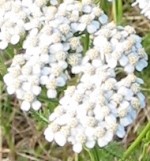 Common yarrow, also known as milfoil, is a rhizomateous herbaceous perennial native to the temperate regions of the Northern Hemisphere Asia, Europe and North America where it grows in open areas such as in meadows, abandon lots, lawns and along roadsides. It is a member of the aster family, Asteraceae, that also includes daisies, goldenrod, and lettuce. Common yarrow prefers full sun and well-drained soil and is frequently seen growing in thin, poor soil. It is an important plant for many beneficial insects and should be treated with respect. Although the species is considered weedy and invasive in many places, many cultivars and hybrids are good garden plants valued for showy colorful flowerheads.
Common yarrow, also known as milfoil, is a rhizomateous herbaceous perennial native to the temperate regions of the Northern Hemisphere Asia, Europe and North America where it grows in open areas such as in meadows, abandon lots, lawns and along roadsides. It is a member of the aster family, Asteraceae, that also includes daisies, goldenrod, and lettuce. Common yarrow prefers full sun and well-drained soil and is frequently seen growing in thin, poor soil. It is an important plant for many beneficial insects and should be treated with respect. Although the species is considered weedy and invasive in many places, many cultivars and hybrids are good garden plants valued for showy colorful flowerheads.
Description: Growing 1-2′ tall, common yarrow has stems covered with grayish hairs and tend to branch near the top. The narrow dark green leaves are up to eight inches long, two to three times pinnately divided, feathery, aromatic, and mat-forming. In early summer flowering stems arise carrying two-four inch wide convex corymbs of quarter inch flowerheads over a long bloom time. The flowersheads of the species are usually white but can be yellow or pink .
Control: Common yarrow spreads by seed and rhizomes. Hand pull, mow, or cut seedlings as soon as they emerge and continue doing so every week or two until no more sprouts appear. Large plants can be dug out taking care to remove all the creeping roots. Applying a dense mulch of newspaper, cardboard, or similar material is also effective. Make sure plants are eliminated before blooming and going to seed. In extreme cases a selective herbicide like 2,4 D can be applied but several applications will be needed because of high resistance.